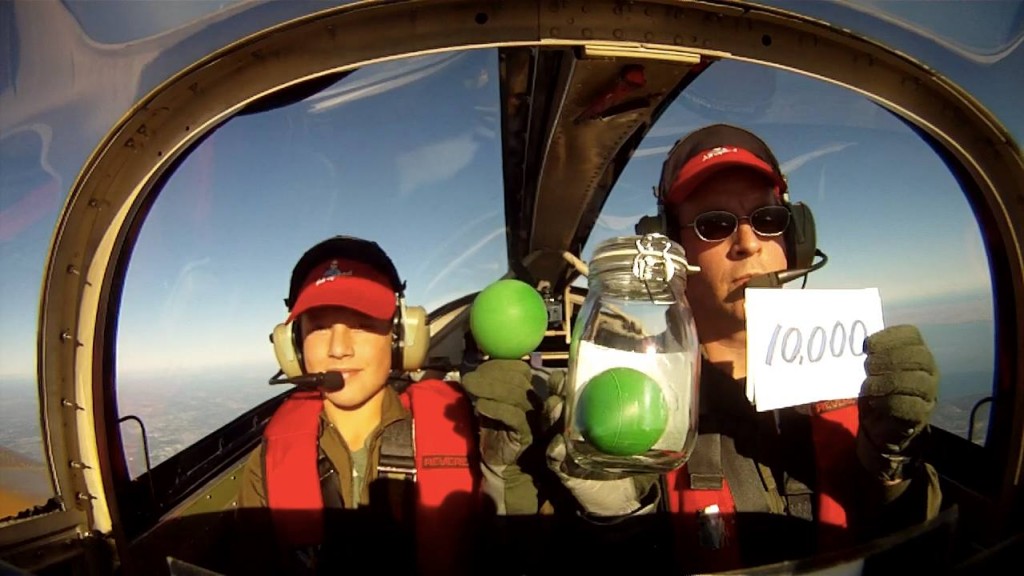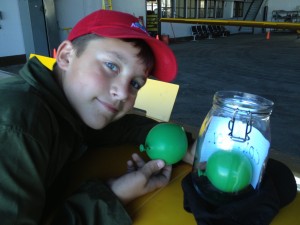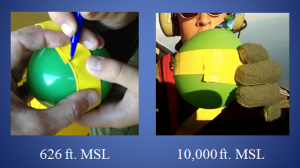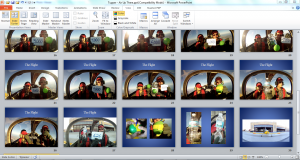Sixth grade was rough for me. I was 5’4” and clumsy, I read a lot of Heinlein, and I was much more comfortable around adults than my age peers. I remember spending a lot of time wishing that there was some way that I could really impress the other kids with the deep thoughts that I was thinking. But, alas, I never managed to do that.
Fast forward to a couple of weeks ago. My son is now in sixth grade. Thankfully, he’s much better adjusted than I was and at least as smart. But he also longs for ways to demonstrate to his peers the awesomeness of the thoughts he thinks. He arrived home one day and announced that he was to be “scientist of the week” in his science class. He was supposed to do a science experiment and report on it in class. He and I thought for awhile and hatched a plan.
On that Tuesday, the skies were clear and visibility was unlimited. I met him at the doors of his school as classes let out in the afternoon. I wore my flight suit. (Because, of course, it’s always good for your classmates to hear that your dad met you at the door wearing a flight suit.) We drove to the airport, preflighted a TG-7A motorglider, loaded our scientific instruments and implements of destruction into the aircraft, and launched for a piece of airspace out between Detroit City Airport (KDET) and Selfridge ANGB (KMTC).
The idea was to take two balloons to 10,000 ft. MSL. One out in the unpressurized cockpit and one sealed in a mason jar as a control. We’d observe the experimental balloon every 1,000 feet or so and then measure it 10,000 feet. We could also visually compare it to the control balloon in the jar.
I’m working on my CFI in gliders and, if I have someone else in the aircraft (other than when I’m flying formation), I take the instructor seat on the left and the other person takes the primary pilot seat on the right. (Air Force doctrine calls for the stick to be in the right hand and the power in the left and, because there’s only one throttle and it’s in the center, the PIC sits on the right side in the TG-7A.) This means that I can let my son do most of the flying from right after takeoff until just before landing. I get practice flying from the left seat while also honing my instructor skills while he flies.
I gave him the controls just after rotation and we flew north of the field and began to climb. He circled up and I held up the balloon(s) for the camera, along with note cards with the altitudes on them. At 10,000 MSL, I did the measurement, and then we pulled the throttle and circled back down and landed.
The experimental balloon didn’t grow as much as we thought it would. We actually worried about that. There was no apparent difference between the experimental and control balloons if you just eyeballed them. But, when we measured, we found that the circumference did expand from 25.5 cm to 29 cm. Assuming that the balloon is spherical (close enough), that’s a 41% growth in volume. After (not before!) doing the calculations, we compared our results to the actual difference in atmospheric pressure for a standard atmosphere and found that the balloon’s expansion was within 2% of the 43% drop in atmospheric pressure in a standard atmosphere.
We did a PowerPoint presentation summarizing the experiment and he delivered it for the class on Friday. It went over extremely well. The teacher even called in the other science teacher to watch once the first slide with an aircraft on it popped up and made it apparent that the presentation was going to be special.
Lessons learned (among many others):
(a) It’s okay to have preconceptions about what will happen, but be objective about your data-taking and accept the data. The best scientists know that it would be even cooler if the experiment had yielded results different from what you expected. Isaac Asimov put it well: “The most exciting phrase to hear in science, the one that heralds new discoveries, is not ‘Eureka!’ but ‘That’s funny . . .’”
(b) Aviation captures imaginations. The presentation made a huge impression in the class. It held the class’s attention and even drew in the other teacher. Every kid in the room understood the results.
(c) You can become a legend at your school if you present photographic evidence that, at the age of 11, you flew a TG-7A nearly two miles high and back.
FOD and I will surely come up with additional excuses to incorporate aviation into his homework. And, in the meantime, we’re spending lots of time flying for flying’s sake. It’s nice having 100 lbs of willing student in the right seat so that I can sit left seat and practice my instructor thing for my CFI certificate.




